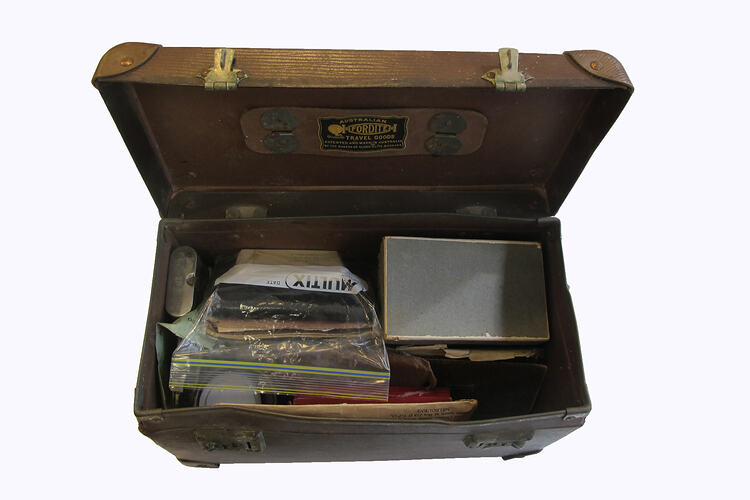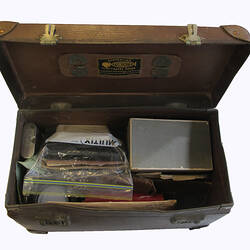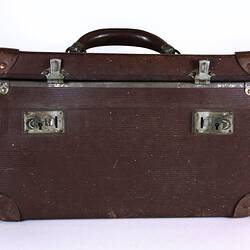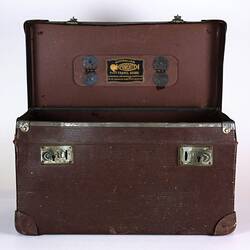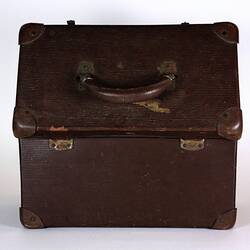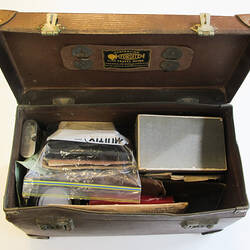Summary
Cardboard Fordite case containing 110 personal effects of World War I soldier Private Michael Ward, collected during his service overseas and the first decades of his post-war life.
Michael ('Mick') Ward, service no. 4138, was an unmarried 26 year old farm labourer when he enlisted to serve in World War I on 26 April (attestation 21 March) 1916. He was born in Eddington, Victoria (possibly on 17 August 1889), the son of Joseph Ward (and possibly Elizabeth Hyde) of Bunga Creek, Cunninghame (later known as Lakes Entrance). He identified as Roman Catholic. The local Bairnsdale paper Every Week noted that 'Mr Michael Ward (Mick) son of Mr J. Ward, a well-known resident of Cunninghame, has enlisted for active service. His cousin Mr C. W. Ward and son Mr W. Ward of Lake Tyers has also joined the colors. Both recruits will go into camp on 22nd April.' Michael was placed in the 29th Battalion (10th Reinforcements).
During his training in Australia Mick spent a few days at Osborne House in Geelong, then a military hospital, and at Ascot Vale isolation camp, where soliders were sent if they had contracted or been in contact with diseases such as measles or mumps. Mick's record for his own illness is blank. From Ascot Vale he was sent to the training camp at Royal Park. He finally embarked on 21 October 1916 on the A16 HMAT Port Melbourne. He was transferred to the 38th Battalion in late 1917, and in early January 1918 went 'into the field' in France.
The 38th Battalion would soon face the German Spring Offensive, the last great push of the war. On 15 April 1918, while the 38th Battalion was located at Buire, west of Saint Quentin in the Somme region, where the trenches were "shelled at intervals", Michael was wounded in action in the legs and hand (he is mentioned by name on page 33 of the Unit Diary for April 1918). His transit label with this collection indicates he was wounded in the left knee; his service record in NAA indicates he had a shrapnel wound in his left knee and a fracture of his right knee (page 29) and also a hand wound (page 11).
He would have been treated firstly at the Aid Post at Buire, a 'very substantial cellar of large size, on the western end of the village. It is now gasproof', reported the Unit Diary (page 43). Michael was transferred east to the 20th CCS (Casualty Clearing Station) at Gezaincourt, then treated at the 1st SA (South African) General Hospital at Abbeville until he embarked for England on 2 May, where he was treated at several more hospitals. He never returned to the front, and was sent back to Australia on the D23, HMAT Runic, which embarked on 23 September 1918. He arrived back in Melbourne on 25 or 26 November 1918, shortly after the Armistice. After his arrival in Melbourne Mick was treated at No.11 AGH - Caulfield Military Hospital. In November 1918 his daily rate of pay was noted as 6/-, with an "allotment" of 3/- as an "incapacitated member of the Australian Expeditionary Forces". In February 1919 he was well enough to sign up for the Army Reserve; yet it appears his discharge from service was delayed until 20 February 1921 because he was still undergoing treatment for war wounds. At some stage after the war he lived at Bunga Creek, Lakes Entrance (possibly his parents' home), and later in Brady Road, Bentleigh. Mick Ward died on 13 June 1962, aged around 72, in Heidelberg, Melbourne - possibly at the Heidelberg Repatriation Hospital.
Amongst the other possessions are references to Barney, corresponding with a 'lonely girl' named Eva.
Physical Description
Brown moulded suitcase containing various personal effects and documents.
Significance
The Ward collection provides a comprehensive personal story, in contrast to much of the World War I material held by Museum Victoria. The closest equivalent would be the Albert Kemp Mourning Collection, for which the Ward collection would be an ideal companion, reflecting the life of a soldier who survived the war.
More Information
-
Collection Names
-
Collecting Areas
-
Previous Owner
Private Michael (. Ward - Australian Imperial Force (AIF), 1914-1930
-
Inscriptions
Suitcase label: 'Fordite'.
-
Classification
-
Category
-
Discipline
-
Type of item
-
Overall Dimensions
430 (Length), 20 (Width), 360 (Height)
Of pennant unfurled
-
References
Location of base hospital and CCS: 'The Long Long Trail' web site [Link 1] accessed 2 June 2016. WARD Michael : Service Number - 4138, National Archives of Australia barcode 8347184. WAR ITEMS. (1916, March 30). Every Week (Bairnsdale, Vic. : 1914 - 1918), , p. 4. Retrieved May 26, 2016, from [Link 2]
-
Keywords
